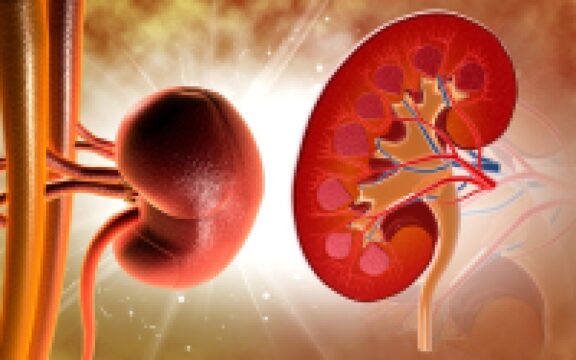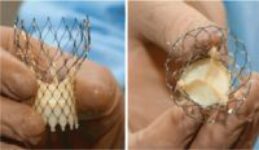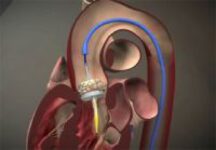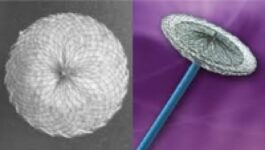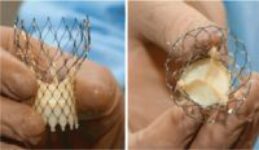Original title: Renal Function-Based Contrast Dosing Predicts Acute Kidney Following Trancatheter Aortic Valve Implantation Reference: Masanori Yamamoto, et al. J Am Coll Cardiol Intv 2013;6:479–86. Acute kidney injury (AKI) presents in 10 to 30% of patients undergoing TAVI; it is associated to the increase of morbidity and mortality and it prolongues hospitalization. This study included 415 patients with…
QRS after TAVI, The Best Predictor for safe transitory pacemaker removal
Original title: Patients Without Prolonged QRS After TAVI with CoreValve Device do not Experience High-Degree Atrio-Ventricular Block. Reference: Gauthier Mouillet et al. Catheterization and Cardiovascular Interventions 81:882–887 (2013). High degree atrioventricular block (AVB) in the context of transcatheter aortic valve implantation (TAVI) has been reported with variable incidence (3-45%) depending on the population characteristics and the kind of…
Prosthetic endocarditis after TAVI, rare and difficult to diagnose
Original title: Prosthetic valve endocarditis after transcatheter aortic valve implantation: the incidence in a single-centre cohort and reflections on clinical, echocardiographic and prognostic features. Reference: Miriam Puls et al. EuroIntervention 2013;8:1407-1418. Prosthetic valve endocarditis is a serious complication of surgical valve replacement and occurs in 0.3 to 1.2% of patients per year. It is basically divided in early…
Low Gradient Severe Aortic Stenosis despite Preserved Ejection Fraction
Original title: Invasive Hemodynamic Characteristics of Low Gradient Severe Aortic Stenosis Despite Preserved Ejection Fraction. Reference: Juliane Lauten et al. J Am Coll Cardiol 2013;61:1799–808. Although the pathophysiology, clinical features, and natural course of severe aortic stenosis have been extensively described, management recommendations are still evolving. The current European and American guidelines recommend a valve area cutoff of…
Post TAVI Hypertension is a predictor of better evolution
Original title: Post-Procedural Hypertension Following Transcatheter Aortic Valve Implantation Incidence and Clinical Significance. Reference: Gidon Y. Perlman et al. J Am Coll Cardiol Intv 2013. Article in press. Pre-procedural hypertension (HTN) is a risk factor and a predictor of increased mortality after surgical aortic valve replacement (AVR). The disappearance of the pressure gradient across the aortic valve following…
Coronary Obstruction after TAVI: dreaded, but rare and solvable
Original title: Coronary Obstruction After Transcatheter Aortic Valve Implantation. A Systematic Review. Reference: Henrique Barbosa Ribeiro et al. J Am Coll Cardiol Intv 2013. Article in press. In the context of Transcatheter Aortic Valve Implantation (TAVI) there can be complications such as conduction disturbances, bleeding, residual aortic insufficiency or vascular complications, all of which have been detailed with…
Valve-in-Valve Implantation Is Possible
Original title: 5 Years Experience With Trancatheter Tranaspical Mitral Valve –in Valve Implantation for Bioprosthetic Valve Dysfunction Reference: Anson Cheung et al. J Am Coll Cardiol 2013;61:1759–66. Percutaneous valves development, first aortic and now mitral, has brought an opportunity to improve life quality and extend life for high risk non-surgical patients. 23 patients received transapical implantation in mitral…
Foramen ovale closure for cryptogenic stroke
Original title: Closure of Patent Foramen Ovale versus Medical Therapy after Cryptogenic Stroke. Randomized Evaluation of Recurrent Stroke Comparing PFO Closure to Established Current Standard of Care Treatment (RESPECT). Reference: John D. Carroll et al. N Engl J Med 2013;368:1092-100. It is still unclear if the closure of patent foramen ovale (PFO) is effective in preventing recurrent stroke…
The need for pacemaker post TAVI does not change the prognosis
Original title: Impact of Permanent Pacemaker Implantation on Clinical Outcome Among Patients Undergoing Transcatheter Aortic Valve Implantation. Reference: Lutz Buellesfeld et al. J Am Coll Cardiol 2012;60:493–501 Although pacemaker implantation after a percutaneous aortic valve (TAVI) implantation, constitutes a significant proportion of the complications related to the procedure, this is generally considered a benign event. This study analyzed…
CoreValve versus Edwards. Equivalent results at one year
Original title: Transcatheter Aortic Valve Implantation With the Edwards SAPIEN Versus the Medtronic CoreValve Revalving System Devices. A Multicenter Collaborative Study: The PRAGMATIC Plus Initiative (Pooled-RotterdAm-Milano-Toulouse In Collaboration). Reference: Alaide Chieffo et al. J Am Coll Cardiol 2013;61:830–6. Since the introduction of percutaneous aortic valve replacement (TAVR), two devices have been widely used. For one side, the self-expanding…
Severe Mitral Insufficiency Following Mitral Valvotomy
Original title: Acute Severe Mitral Regurgitation Following Balloon Mitral Valvulotomy: Echocardiographic Feature, Operative Finfing and Outcome in 50 Surgical Cases. Reference: Manjunath C. Nanjappa, et al. Catherization and Cardiovascular Intervention 81:603-608 (2013) Severe Mitral Insufficiency Following Mitral Valvotomy (VPM) is a major complication; though not frequent, (0.9%-2%) it is life threatening and requires resolution through valve replacement. The…
